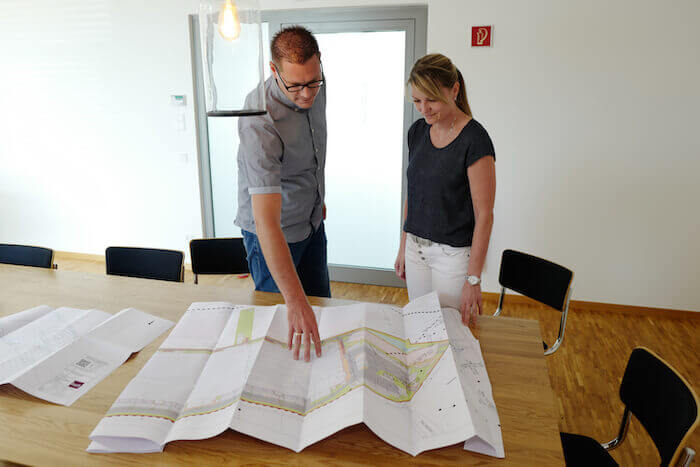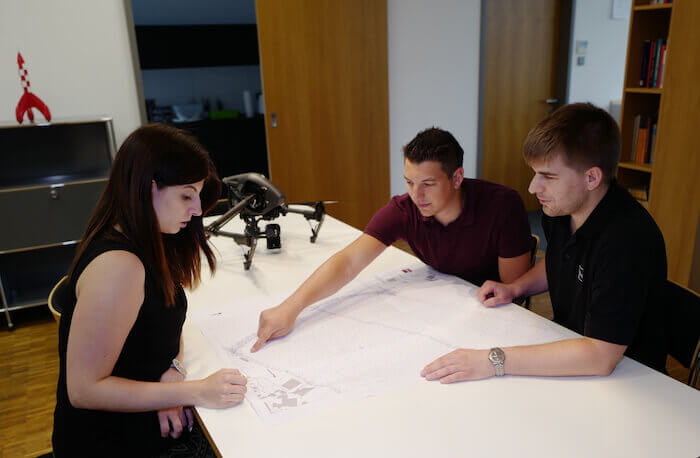Structural monitoring
(deformation monitoring, settlement measurements, flatness inspections)
Structural monitoring involves the ongoing examination of structures (buildings, dams, etc.) for emerging deformations or settlement using surveying technology to check on the structural integrity of the construction.
For larger surfaces (for example in logistics warehouses), we also conduct flatness inspections in accordance with DIN 18202 – Tolerances in Building Construction.
Structural monitoring
After completion, buildings and structures must be monitored through technical measurements to check on their structural stability.
With structural monitoring, deformations and settlements can be detected at an early stage.
By conducting permanent monitoring, data can be collected and analyzed so as to take preventive action against faults, to renovate damages that have occurred and to ensure safety and quality.
The importance of structural monitoring
Geodetic structural monitoring is mainly concerned with measurements of deformations and settlement. Deformations may result from external of internal influences which could result in a building losing its bearing capacity. Also of relevance here is that buildings certainly show wear over time, but at the same time requirements on their bearing capacity often increase as a result of external factors. Therefore structural monitoring is absolutely essential when such factors have been identified. By means of structural monitoring, deformation measurements and settlement measurements, it is not only possible to determine whether a building is settling or deforming, but also to see in which area these problems are arising and what is causing them.
With structural monitoring, buildings, individual construction components and particularly supporting structures are monitored (i.e. surveyed) on an ongoing basis. In addition to deformations and developing settlement, oscillations and temperature are also measured.
Particularly in structures subject to high stress and loads – for example bridges – ongoing measurement procedures are essential to ensure the prevention of damages and defects. Through structural monitoring it is also possible to reduce maintenance and renovation costs.
For builders and developers it is not only of interest to conduct structural monitoring on one’s own properties. New buildings can often cause deformations in neighboring structures. To be in a good position to counter possible claims due to such damages, the condition of neighboring buildings should be examined prior to the commencement of construction. On this basis it is possible to compare and determine whether changes have resulted as a result of the new construction.
The inspection of the buildings is performed by an engineer who evaluates the static and design aspects of the structure and also reviews external influences such as increasing traffic, for example. A visualization of deformations on building surface models can be calculated using three-dimensional measurement data.
Deformation monitoring
We monitor deformations on buildings using the latest measurement methods and on the basis of our many years of experience. Unfortunately, it is normally not possible to prevent building deformations over time. However, ongoing measurements can ensure that buildings meet all relevant standards and that no unnecessary risks occur. In addition, deformation monitoring does allow important preventive measures to be implemented through timely maintenance work to counter deformations that are in the process of developing.
There are a range of factors that can result in slight to severe deformation in a structure. These include natural causes such as changes in the subsoil but also may involve increasing or decreasing loads on the structure or wear and tear of building materials. Depending on whether external or internal factors are involved and which measurement method is used, various measurement instruments are employed such as geotechnical or geodetic measurement sensors.
Monitoring structures for deformations is one of the most important activities in the field of engineering geodesy. Particularly critical are structures subject to imminent risks, such as bridges or buildings on inclines. But also without these imminent threats, deformation measurements can be beneficial in order to detect unexpected changes at an early date and to analyze relevant data. Deformation monitoring is not only performed with buildings but also with machines.
Settlement measurements
Settlement refers to the slow sinking of a building structure through the gradual compression of the subsoil beneath it. In most cases the weight of the building is responsible for this process. Settlement measurements are straight elevation measurements through which the amount of settlement can be determined.
Over time, subsoils develop that have varying degrees of density, particularly as a result of sedimentation. This means that there may be cavities in the ground. Basically, every sort of regolith (soil) can be compressed further, and is, in fact, compacted over time through the heavy weight of a building structure. This is the why the bases of buildings typically sink a few millimeters already during the construction process. Prior to construction, the subsoil should be analyzed to take into account settlement that can be expected during construction.
Settlements can also occur through heavy traffic because this also results in vibration and further compression of the ground. Lowering of the water table or drying up of the ground can also result in settlements and soil subsidence. In this context, settlement measurements after the completion of buildings can be of great relevance. Large structures are a particular focus for long-term monitoring so that preventive action can be taken if necessary. Geodesists conduct elevation measurements at regular intervals which are always made from geologically stable points.
Through the leveling of building points (meaning the definition of specific points of elevation), it can be checked whether and how much a building is sinking. To determine the change in elevation of the whole structure, measurements with line levelings to fixed points are made.
Settlement measurements have become very exact in the meantime and can determine differences as small as 0.1 millimeters. These measurements are an important component of the overall structural monitoring and should be conducted prior to the construction and also at regular intervals after the completion of construction.
Flatness inspections
With larger surfaces, we can also conduct flatness inspections for you in accordance with DIN 18202. This standard specifies the quality with which surfaces need to be produced. Flatness inspections are performed with a straightedge. Taking the measurement with a surface leveling can also be performed in some cases; this makes it possible to subdivide the surface into a grid.
Thanks to modern measurement methods we can also combine location and height measurements and store them using 3D coordinates. Depending on the surface and the quality requirements, laser trackers or laser scanners may also be used which automatically register the course of the measurements.
Optimized measurement methods for structural monitoring
Comprehensive monitoring and evaluation of building structures requires the right monitoring systems to allow for early detection of settlements and deformations so as to be able to take effective counter measures. This not only ensures safety and usability, it also provides the basis for preventive action.
Our services in the area of structural monitoring include the development of measurement plans and concepts, installation and maintenance of monitoring systems, load estimates, material wear evaluations and action recommendations on the basis of analyzed data.

